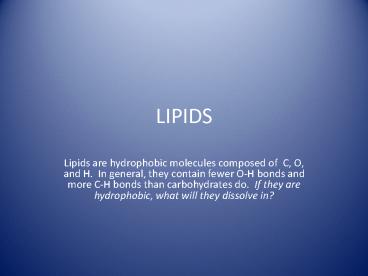LIPIDS - PowerPoint PPT Presentation
1 / 26
Title: LIPIDS
1
LIPIDS
- Lipids are hydrophobic molecules composed of C,
O, and H. In general, they contain fewer O-H
bonds and more C-H bonds than carbohydrates do.
If they are hydrophobic, what will they dissolve
in?
2
WHAT DO ORGANISMS USE LIPIDS FOR?
- Storing Energy
- Building Membranes and other cell parts
- Chemical Signaling Molecules
3
Types of Lipids (families)
- Fats
- Phospholipids
- Steroids
- Waxes
4
Fats
- Most common energy storing molecule
- 1 gram of fat stores 38 kJ (9 kilocalories)
- (one calorie (cal) 4.18 J, 1 Cal (1kcal) 4.18
kJ - What is a calorie?
5
Adipose Tissue
- Animals convert excess carbohydrate to fat
- Fat molecules are stored in fat droplets in the
cells of adipose tissue - The layer of fat beneath the skin acts as thermal
insulation
6
Adipose tissue
7
Plants and fats
- Plants store fats as oils
- Fats and oils are made from two kinds of
molecules glycerol and fatty acids
8
Structure of Fatty Acids
- tail of a fatty acid is a long hydrocarbon
chain (16 -18 carbons long), making it
hydrophobic. The head of the molecule is a
carboxyl group which is hydrophilic.
9
Most common lipid
- Triglycerides
- Glycerol and 3 fatty acids
10
Saturated vs Unsaturated Fatty Acids
- Saturated fatty acids have only single bonds
between carbons atoms - They are saturated because they have the maximum
number of H bonds attached to the carbons - Unsaturated fatty acids have one or more carbon
carbon double bonds - They have fewer than the maximum number of H
bonds attached to the carbons
11
Poly and mono saturated
- Polyunstaturated fatty acids
- Have many CC bonds
- Monounsaturated fatty acids have one CC bond
12
Solid vs liquid
- Straight chains of fatty acids allows them to fit
together very closely allowing van der Waals
forces along the length - (Van der Waals forces occur between molecules of
the same substance - They include dipole forces, dispersion forces and
hydrogen bonding) - Result is solid consistency at room temperature
13
Solid vs Liquid
- Unsaturated fatty acids are commonly found in
plant oils - The bending of the hydrocarbon chains with CC
prevents/reduces van der Waal attractions,
causing oils to be liquid at room temperature - (see page 36 in text)
14
Hydrogenation
- Industrial process that adds H atoms to the CC
bonds of unsaturated fatty acids rendering
vegetable oils to be solid at room temperature
15
Cis and Trans Fatty Acids
Trans
Cis
- The Latin prefixes Cis and Trans describe the
orientation of the hydrogen atoms with respect to
the double bond. - Cis means "on the same side" and
- Trans means "across" or "on the other side".
- Naturally-occurring unsaturated vegetable oils
have almost all cis bonds - Trans fatty acids are carcinogenic
16
Phospholipids
- glycerol two fatty acids a phosphate group
17
Hydrophobic and Hydrophilic
- The fatty acids - hydrophobic,
- The phosphate group - hydrophilic
- This means that phospholipids are soluble in both
water and oil.
18
Micelle
- When added to water, phospholipids form spheres
micelles. (see page 38) - The hydrophilic heads dissolve in water, the
hydrophobic tails mix in the centre of the sphere
19
Membranes and Phospholipids
- Cell membranes - double layer of phospholipids
- Fatty acids form inside
- Phosphate group face out on both surfaces.
20
Function of Cell Membrane
- Separates two water compartments
- Cytoplasm and extracellular fluid
- Allows two areas to distinct
- Homework describe a cell membrane and the
function of it. - http//www.cytochemistry.net/Cell-biology/membrane
_intro.htm
21
Steroids
22
Good Steroids
- Estrogen, progesterone, corticosteroids,
aldosterone, testosterone, and Vitamin D. - Four fused hydrocarbon rings and functional
groups.
23
Cholesterol
- Precursor to sex hormones and Vitamin D
- Sunlight changes cholesterol to Vit. D
- Is important part of cell membranes
- Gives a fluid nature to membrane in colder
temperatures
24
Artherosclerosis
- Read Page 38 of your text and describe what this
is.
25
Waxes
- Long chain fatty acids linked to alcohols or
carbon rings - They form firm, pliable molecules
- Useful as waterproof coatings for plants and
animals - Cutin covers leaves, stems and fruit
- Beeswax used to construct honeycombs
26
Task
- Questions 11 18 on page 40































